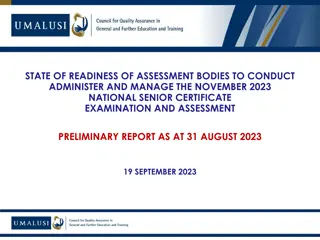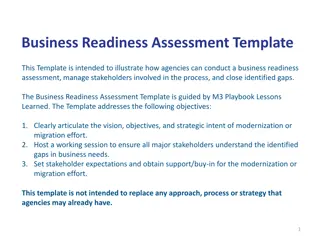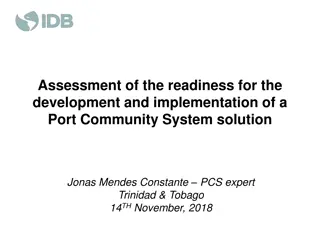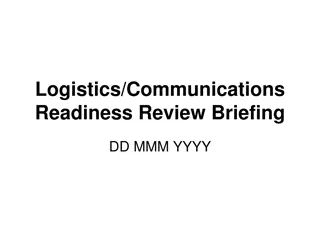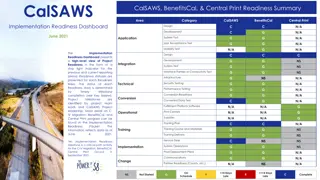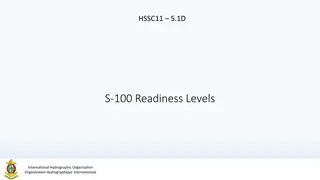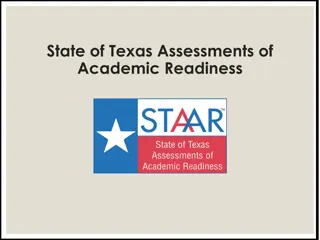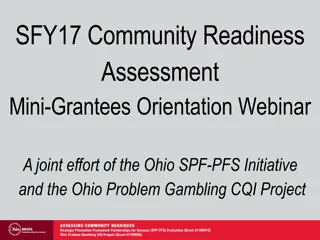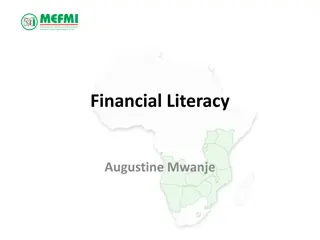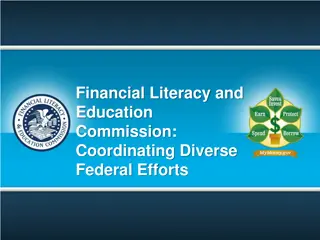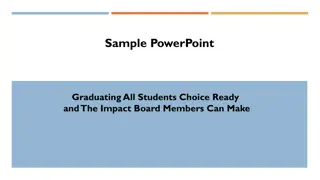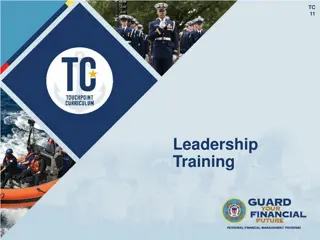Financial Readiness and Planning for Service Members
Gain valuable insights into financial management as a service member. Explore topics such as compensation, military banking, spending plans, debt management, and credit understanding through helpful resources and actionable guidelines. Equip yourself with the knowledge needed to secure your financial well-being while serving your country.
Download Presentation

Please find below an Image/Link to download the presentation.
The content on the website is provided AS IS for your information and personal use only. It may not be sold, licensed, or shared on other websites without obtaining consent from the author.If you encounter any issues during the download, it is possible that the publisher has removed the file from their server.
You are allowed to download the files provided on this website for personal or commercial use, subject to the condition that they are used lawfully. All files are the property of their respective owners.
The content on the website is provided AS IS for your information and personal use only. It may not be sold, licensed, or shared on other websites without obtaining consent from the author.
E N D
Presentation Transcript
TC 2 First Duty Station Internal
Agenda Compensation and military banking Basic finance Consumer protection Education and career planning Insurance Saving and investing Thrift Savings Plan Internal
Compensation Basic Pay Special and Incentive Pays Allowances https://www.dcms.uscg.mil/ppc/mas/rates/#allowances Internal First Duty Station Checklist Available
Payslip Earnings Taxes, Deductions and Allotments Remarks https://www.dcms.uscg.mil/Portals/10/CG- 1/PPC/guides/GP/SelfService/Member/Self %20Service%20-%20ViewMyPaySlip.pdf Internal
Military Banking Types of banking institutions Things to consider Products and services offered Online and mobile banking Credit and debit cards Bank statements Review, protect your accounts Internal Military Banking Handout Available
Spending Plan STEP 1: Understand your current situation Set goals Track inflows and outflows STEP 1: Understand your current situation STEP 2: Know where your money should go Save and/or invest 10% 15%* Transportation less than 15% 20%* Housing Limit to BAH or 25% 30%* STEP 2: Know where your money should go STEP 4: Make adjustments 4-STEP BUDGETING PROCESS STEP 3: Create a plan Pay yourself first Automate saving and bill paying Strive to save 3 6 months of expenses for emergencies STEP 3: Create a plan STEP 4: Make adjustments Make family budgeting a team sport Replenish emergency funds as needed Review frequently * Pretax income Internal Spending Plan Worksheet Handout and Checklist Available
Manage Debt and Credit Tips to Create Healthy Credit Habits Create and follow a spending plan Pay bills on time Strive to pay credit cards in full each month Keep credit card and loan information safe Keep your receipts and compare charges with billing statements New Credit 10% Types of Credit 10% Length of Credit History 15% Payment History 35% Amounts Owed 30% Understand and Protect Your Credit Reputation (Score) Know the Factors that Determine Your Credit Score Internal Understanding Credit Handout Available
Your Tax Situation Review your tax situation Make changes in Direct Access: hcm.direct-access.uscg.mil/ Understand state residency and income tax Military Spouse Residency Relief Act (MSRRA) Visit CGSUPRT.com for free tax software and/or to speak with a Money Coach for professional assistance Internal
Why Are Service Members Vulnerable? Young Away from home Deployments Frequent moves Spouse unemployment Internal
Misleading Consumer Practices Recognize scams Multilevel marketing/pyramid scheme Get rich quick Too good to be true Protect yourself Research Comparison shop Sleep on it Report a complaint Internal Sources of Help for Military Consumers Handout Available
Identity Theft Secure your information Follow PII regulations and procedures Safeguard your wallet Sign up for electronic statements Optoutprescreen.com Donotcall.gov Periodically review credit report Update computer security settings Avoid unsecure Wi-Fi networks Active Duty alert or credit freeze Identity theft resources identitytheft.gov consumer.gov Internal Military Consumer Protection Handout Available
Military Lending Act (MLA) Protects Active Duty, Active Guard/ Reserves, dependents Protection from predatory lending Interest rate capped at 36% Internal Military Consumer Protection Handout Available
Servicemembers Civil Relief Act (SCRA) Contracts Loan rate capped at 6% Terminate residential or auto lease Cancel cellphone service contract Stay civil judgments Eviction and foreclosure Default judgment Property repossession or seizure Insurance Life insurance premium payments Health insurance reinstatement State income tax statutes Internal Servicemembers Civil Relief Act Handout Available
Make Smart Purchases Think First Logic beats emotion Additional costs matter Shopping around is smart Cash or credit Avoid Trouble Want or need Wait and save Ask someone else Internal Major Purchases Handout Available
Car-Buying Basics Three Deals of Car Buying 3. Trade 2. Financing 1. Purchase Price Interest Rate Term Payments Loan Amount Total Interest Paid 3 + $16,416 $456 x 36 $15,000 $1,416 Years 6% APR 4 + $352 x 48 $15,000 $1,896 $16,896 Years 5 + $290 x 60 $15,000 $2,400 $17,400 Years Interest Rate Term Payments Loan Amount Total Interest Paid 3 + $17,424 $484 x 36 $15,000 $2,424 Years 10% APR 4 + $380 x 48 $15,000 $3,240 $18,240 Years 5 + $319 x 60 $15,000 $4,140 $19,140 Years Internal Major Purchases Handout Available
Education and Career Planning Tuition Assistance Paying Back Student Loans United Services Military Apprenticeship Program (USMAP) Credentialing Opportunities On-Line Program (COOL) Internal Education Savings and Benefits and Paying off Student Loans Handouts Available
Health Insurance TRICARE Become familiar with benefits Defense Enrollment Eligibility Reporting System (DEERS) Coordinate other health insurance benefits Visit tricare.mil TRICARE Dental Enroll family members Visit tricare.mil/Dental Internal TRICARE Overview Handout Available
Property and Auto Property Insurance Renters/Homeowners Insurance o Protection for your belongings o Inexpensive Auto Insurance State requirements Loan requirements Internal
Life Insurance Servicemembers Group Life Insurance (SGLI) Coverage Beneficiaries Family Servicemembers Group Life Insurance (FSGLI) Private Life Insurance Term and permanent coverage War clause and other restrictions Beneficiaries Premium payments Internal
LIFE Insurance Needs Liabilities (debts and obligations) Income (amount X number of years needed) Final expenses Education and other goals + + + Subtract current coverage and assets Your Total Need Internal
Saving vs. Investing Saving Safe, low-risk (return of your money) Low interest Short-term goals (emergency funds, vacation, etc.) Investing Takes risk (return on your money) Potential for higher returns Long-term goals (major purchase, retirement, etc.) Internal Basic Investing Handout Available
Compound Interest Time Is Money! Start Saving Early for Your Retirement $1,054,907.88 $ 1M $ 800k $698,201.57 $ 600k $ 400k $298,072.00 $ 200k Pressy saves $200/mo. Starting at age 20 Steve saves $200/mo. Starting at age 35 Mandi saves $200/mo. Starting at age 25 $ 0k Retirement Age 20 25 35 65 MANDI PRESSY STEVE Total Amount Saved with 8% Rate of Return Internal Basic Investing Handout Available
Types of Investments Lower risk Lower return Shorter timeframe Higher risk Potentially higher return Longer timeframe CASH Security Examples: Certificates of Deposit Money Market Account Savings Account BONDS Lending Examples: U.S. Government U.S. Corporate Municipal Foreign Government/Corporations STOCKS Ownership Examples: Small/Medium/Large Co. Stocks U.S./Foreign Stocks This is simply an illustration of the general relationship between various asset classes. Some investments will not align with this model. Internal Basic Investing Handout Available
Mutual Funds and Exchange-Traded Funds (ETFs) ETFs Mutual Funds Tradable throughout the day, like stocks Bought and sold once per day Trading Basket-like investments with many securities (Stocks, bonds, commodities, currencies, etc.) Priced daily after market close based on net asset value (NAV) Prices may fluctuate throughout the day Pricing Typically More often actively managed than passive Equity, fixed-income, or balanced funds Management passively managed Promote diversification Can be more tax efficient Can be less tax efficient Tax efficiency Passive or active management Often have higher expense ratios Often have lower expense ratios Expenses Internal
Investing Things to Consider Invest regularly Invest for the long term Keep emotions out of your actions Avoid high-risk investments Avoid chasing performance Diversify Evaluate your investment plan at least annually Internal Basic Investing Handout Available
Understanding Your TSP Taxes deferred Taxes paid up front Roth Traditional Tax-free when withdrawn Taxable when withdrawn Internal Thrift Savings Plan Handout Available
TSP Investment Choices: Core Funds The TSP offers 5 individual funds that provide board market diversification C FUND Common Stock Index Investment Fund F FUND Fixed Income Index Investment Fund I FUND International Stock Index Investment Fund G FUND Government Securities Investment Fund S FUND Small Capitalization Stock Index Investment Fund What It Is: Stocks of large and medium-sized U.S. companies What It Is: Government, corporate, and asset-backed bonds What It Is: International stocks from more than 20 developed countries What It Is: Government securities that are specially issued to the TSP What It Is: Stock of small to medium-sized U.S. companies Pros: Potential for high investment returns over the long term Pros: Potential for high investment returns over the long term Pros: May earn returns that are higher than money market funds over the long term with relatively low risk Pros: Potential for high investment returns over the long term Pros: Does not lose money; has a consistent but relatively low investment return Risks: Can be volatile depending on stock market performance Risks: Can be volatile depending on stock market performance Risks: Can be volatile depending on stock market performance Risks: Bond prices fall when interest rates rise. Bonds may be repaid early, reducing your returns. Risks: Your money may not grow to meet your retirement needs or outpace inflation. Benchmark Index: Dow Jones U.S. Completion TSM Index Benchmark Index: Standard & Poor s 500 Stock Index Benchmark Index: MSCI EAFE Stock Index Benchmark Index: Bloomberg Barclays U.S. Aggregate Bond Index For more comprehensive information, visit tsp.gov and select Learn about fund options from the menu Internal
TSP Investment Choices: Lifecycle Funds Each L Fund is a mix of individual funds based on when you ll need your money L 2065 L 2060 L 2055 L 2050 L 2045 Consider if you were born after 1999 or plan to withdraw from your account after 2062. Consider if you were born between 1995-1999 or plan to withdraw from your account between 2058-2062. Consider if you were born between 1990-1994 or plan to withdraw from your account between 2053-2057. Consider if you were born between 1985-1989 or plan to withdraw from your account between 2048-2052. Consider if you were born between 1980-1984 or plan to withdraw from your account between 2043-2047. For the long-term investor For the long-term investor For the long-term investor For the long-term investor For the long-term investor L 2040 L 2035 L 2030 L 2025 L INCOME Consider if you were born between 1975-1979 or plan to withdraw from your account between 2038-2042. Consider if you were born between 1970-1974 or plan to withdraw from your account between 2033-2037. Consider if you were born between 1965-1969 or plan to withdraw from your account between 2028-2032. Consider if you were born between 1958-1964 or plan to withdraw from your account between next year and 2027. Consider if you were born between 1958 or already withdrawing from your account. For the long-term investor For the medium-term investor For the medium-term investor For the short-term investor For those already withdrawing With the exception of L Income, the investment mix of each L Fund becomes more conservative over time. To change your investments, log in to My Account on tsp.gov and choose Contribution Allocation or Interfund transfers from the the menu. Internal Thrift Savings Plan Handout Available
Blended Retirement System: Automatic and Matching Contributions Defined Contribution Thrift Savings Plan (TSP) Coast Guard Automatic Contribution (Traditional) 1% 1% 1% 1% 1% 1% Coast Guard Matching Contribution (Traditional) 0% 1% 2% 3% 3.5% 4% You Total Contribute (Roth and/or Traditional) Contribution 0% 1% 2% 3% 4% 5% 1% 3% 5% 7% 8.5% 10% More Than 5% 1% 4% Your Contribution + 5% Service members who joined on or after January 1, 2018: 1% Coast Guard Automatic Contribution begins 60 days after entering service. 4% Coast Guard Matching Contributions begin after completing 2 years of service. Both automatic and matching contributions are vested after serving two years. Internal
Manage Your TSP STEP 1: Visit Direct Access Start stop change o Contribution percentage o Type (Traditional/Roth) Update address STEP 2: Visit TSP.gov View portfolio Manage investments Change allocations Review and update beneficiaries Internal Thrift Savings Plan Handout Available
Summary Congratulations on your First Duty Station assignment! Let s recap what you learned: Compensation and military banking Basic finance Consumer protection Education and career planning Insurance Saving and investing Thrift Savings Plan Internal
Resources Checklist and Handouts Financial Education and Support Command Financial Specialists (CFS) Personal Financial Managers (PFM) Health, Safety and Work-Life (HSWL) Regional Practice CG SUPRT Coast Guard Mutual Assistance (CGMA) Financial Literacy Mobile Apps Coast Guard Work-Life mobile app DoD FINRED Sen$e mobile app Internal
Thank You! The appearance of U.S. Department of Homeland Security (DHS) visual information does not imply or constitute DHS endorsement. Internal




